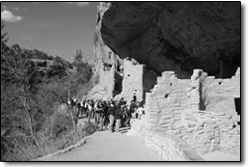|
|
||||
|
Haze lifting over Four Corners New EPA rule still criticized as being too lenient SideStory: Plant cleans up its act: SJ station takes 'leadership' role
by Will Sands The haze over the Four Corners region is beginning to clear. Last week, the Environmental Protection Agency released a new rule aimed at protecting air quality in national parks and wilderness areas. However, some say the rule does not go far enough. For the Four Corners, a region boasting one of the highest densities of parks and designated wilderness in the nation, industry pressure resulted in lighter regulations for two of the dirtiest plants in the country. On June 15, the Clean Air Visibility Rule was signed into existence, and the EPA announced that the air at America’s national parks and wilderness areas had gained further protection. Under the rule, states are required to identify older industrial facilities and power plants that affect visibility in specially protected areas and improve technology or increase emission standards. Plants must submit plans for implementing the haze rule by 2008, initiate reductions by 2014 and have full implementation by 2018. “America’s national parks and wilderness areas are getting a new level of protection,” said Jeff Holmstead, of the EPA’s Office of Air and Radiation. “The Clean Air Visibility Rule means that our views will be clearer and the air healthier.” However, many are taking exception to Holmstead’s statement. They note that while East Coast views and air will benefit from the change, many Western states are being left behind. At the last minute, regulations were softened for the Four Corners region in particular. “In the West, the EPA said that top-of-the-line technology is not warranted,” said Vickie Patton, senior attorney for the watchdog group Environmental Defense. Patton said that is especially true with respect to the Four Corners Power Plant near Farmington and the Navajo Generating Station in Page, Ariz., two of the biggest polluters in the nation and serious detriments to the local airshed. The two plants would have faced stringent standards under the original proposal. However, Patton said that standards were cut in half courtesy of industry pressure. “In the cases of the Navajo and Four Corners plants, the new rule led to a significant relaxation of proposed regulations,” she said. “Ironically, these are two of the biggest sources of smog and haze in the country that 4 are also located in the most significant ring of national parks in the country. Now, the two plants will be allowed to discharge about twice as much as was originally proposed.”
“In the cases of the Navajo and Four Corners plants, the new rule led to a significant relaxation of proposed regulations,” she said. “Ironically, these are two of the biggest sources of smog and haze in the country that 4 are also located in the most significant ring of national parks in the country. Now, the two plants will be allowed to discharge about twice as much as was originally proposed.” Currently, the two plants are notorious nitrogen oxide, or ozone, polluters. Even at low levels, ozone poses dangers to respiratory health, particularly in children. “Collectively, the Navajo Generating Station and the Four Corners plant discharge 77,000 tons of nitrogen each year,” Patton said. “That’s comparable to what’s discharged by 80 million cars.” Patton acknowledged that there will be an improvement in local air quality. But she noted that last week’s announcement has been 25 years in the making. As part of the 1977 Clean Air Act amendments, Congress pushed restoration of clear vistas in premier national parks and wilderness areas. “In part, the original Congressional mandate was due to a pointed concern about air quality in the Four Corners region, where you have a cluster of national parks and wilderness areas like nowhere else in the country,” she said. The last-minute changes to the rule amount to a short-change for local and regional residents, according to Patton. “I think the public has waited a quarter century for government officials to meaningfully implement the Clean Air Act. After 25 years, the final regulations are in many respects a missed opportunity.” All eyes will now turn to the EPA and the Navajo Nation, both of which will be responsible for enforcing the regulations on the Navajo Generating Station and the Four Corners Power Plant. “One of the pivotal questions that will unfold very quickly is, to what extent will the EPA and the tribes vigorously enforce the new guidelines and whether there will be a concerted effort to regain some of the good that was lost when the EPA weakened the proposed guidelines,” Patton concluded. •
|
In this week's issue...
- May 15, 2025
- End of the trail
Despite tariff pause, Colorado bike company can’t hang on through supply chain chaos
- May 8, 2025
- Shared pain
Dismal trend highlights need to cut usage in Upper Basin, too
- April 24, 2025
- A tale of two bills
Nuclear gets all the hype, but optimizing infrastructure will have bigger impact



